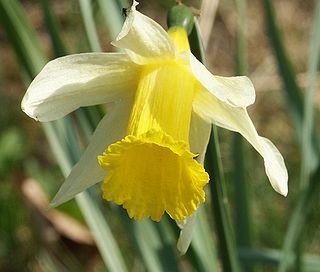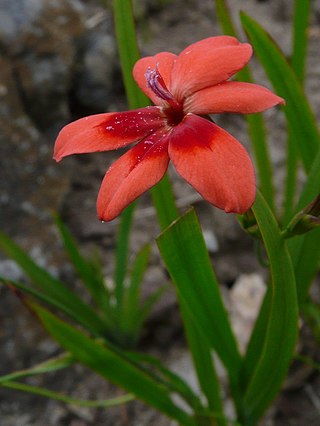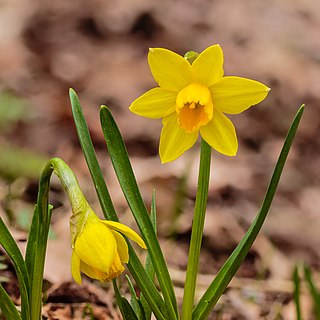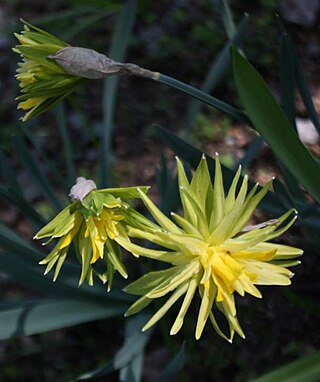
Narcissus is a genus of predominantly spring flowering perennial plants of the amaryllis family, Amaryllidaceae. Various common names including daffodil, narcissus and jonquil, are used to describe all or some members of the genus. Narcissus has conspicuous flowers with six petal-like tepals surmounted by a cup- or trumpet-shaped corona. The flowers are generally white and yellow, with either uniform or contrasting coloured tepals and corona.
This is an alphabetical index of articles related to gardening.

Narcissus pseudonarcissus, commonly named the wild daffodil or Lent lily, is a perennial flowering plant.

Freesia laxa, commonly known as flowering grass, is a small species of cormous flowering plant in the family Iridaceae, from eastern and southern Africa, from Kenya to northeastern South Africa. It is grown in gardens as an ornamental plant.

Erythronium revolutum is a species of flowering plant in the family Liliaceae which is known by several common names, including mahogany fawn lily, coast fawn lily, and pink fawn lily. It is native to the west coast of North America.

Pachysandra terminalis, the Japanese pachysandra, carpet box or Japanese spurge, is a species of flowering plant in the boxwood family Buxaceae, native to Japan, Korea and China and introduced to eastern North America. It is a slow-growing, spreading evergreen perennial growing to 10 cm (4 in) tall by 60 cm (24 in) broad, with alternate, simple, glossy leaves, and creeping stems. The leaves may yellow in direct sunlight or in winter. When growing in a spreading mass of many plants, a dense cover is formed.

Narcissus triandrus, also known as the Angel's Tears daffodil, is a species of flowering plant within the family Amaryllidaceae.

Narcissus romieuxii is a species of flowering plant in the family Amaryllidaceae. It is a distinctive, early-flowering daffodil with dark green rush-like foliage. The flowers have narrow perianth segments, while the trumpet is wide and flaring. It blooms in mid to late winter. There are many subspecies and cultivars, with flowers in many shades of white and yellow. It originated in the Atlas Mountains region of Morocco.

Tecophilaea cyanocrocus, the Chilean blue crocus, is a flowering perennial plant that is native to Chile, growing at 2,000 to 3,000 m elevation on dry, stony slopes in the Andes mountains. Although it had survived in cultivation due to its use as a greenhouse and landscape plant, it was believed to be extinct in the wild due to overcollecting, overgrazing, and general destruction of habitat, until it was rediscovered in 2001.

Narcissus bulbocodium, the petticoat daffodil or hoop-petticoat daffodil, is a species of flowering plant in the family Amaryllidaceae, native to southern and western France, Portugal, and Spain. Some sources say that the species is also native to Morocco, but this is based on populations formerly thought to be varieties of N. bulbocodium but now regarded as separate species.

Narcissus cyclamineus, the cyclamen-flowered daffodil, is a species of flowering plant in the family Amaryllidaceae, native to North West Portugal and North West Spain.
Alec Gray (1895-1986) was an English nurseryman and horticulturalist. He was notable as an authority on and breeder of daffodils, having developed over 100 new cultivars over a career spanning 60 years. In his free time he was also an enthusiastic archaeologist and poet.

Narcissus minor, the lesser daffodil or least daffodil, is a species of Narcissus within the family Amaryllidaceae. The species and its cultivar 'Little Gem' have both gained the Royal Horticultural Society's Award of Garden Merit.

Narcissus 'Tête-à-tête' is a hybrid cultivar of Narcissus, which was introduced in 1949. It is one of 110 cultivars produced by British daffodil breeder Alec Gray. 'Tête-à-tête' is a popular ornamental plant, which is known for its very early flowering period and short stature. This cultivar is commonly used as a garden plant where it can be planted in pots, rock gardens, garden borders and even naturalized in lawns. The cultivar name 'Tête-à-tête' means to have a conversation between two people, which relates to the cultivar often hosting a pair of flowers per stem.

Narcissus 'Rip van Winkle' is an heirloom cultivar of Narcissus, which was first introduced commercially in 1884. When the cultivar was produced is unknown, however it is believed this historic cultivar originated in Irish gardens. The cultivar was first distributed by plantsman William Baylor Hartland of Country Cork, Ireland.

Narcissus 'King Alfred' is a cultivar of daffodil which originates in the county of Devon, United Kingdom. The cultivar is named after English king of the Anglo-Saxons, Alfred the Great.

Narcissus 'Thalia', also sometimes known as the orchid Narcissus, is a cultivar of daffodil, which was bred by M. van Waveren and Sons of Hillegom in 1916. The cultivar was produced by hybridizing an unnamed daffodil with Narcissus triandrus subsp. triandrus var. triandrus.

Narcissus 'Sun Disc' is a hybrid cultivar of daffodil, which was introduced in 1949. It is one of 110 cultivars produced by British daffodil breeder Alec Gray. The cultivar was produced by hybridizing Narcissus rupicola with Narcissus poeticus.
James Kirkham Ramsbottom was an English botanist. He became interested in the field after he was recommended to pursue an outdoor career for his health. After a short period at the Chelsea Physic Garden Ramsbottom studied at the RHS Garden Wisley. Coming first in their diploma examinations Ramsbottom became a research student at the Royal Horticultural Society (RHS) in 1913. He studied leaf blotch disease in irises and became assistant editor of the Gardeners' Magazine.


















